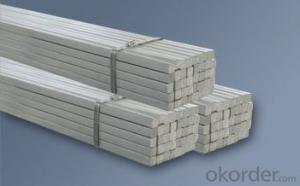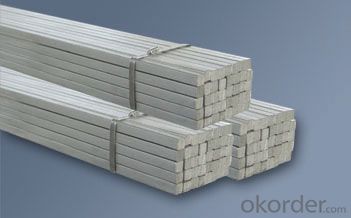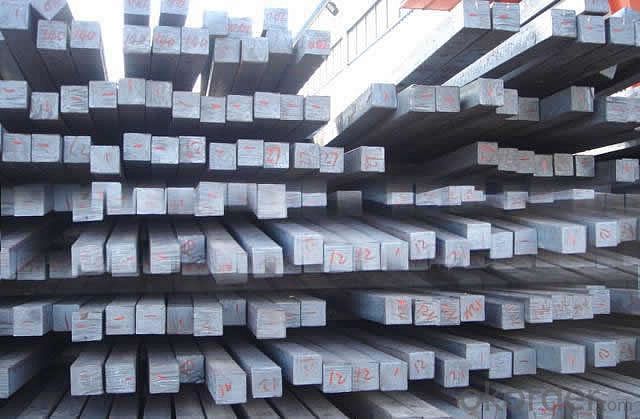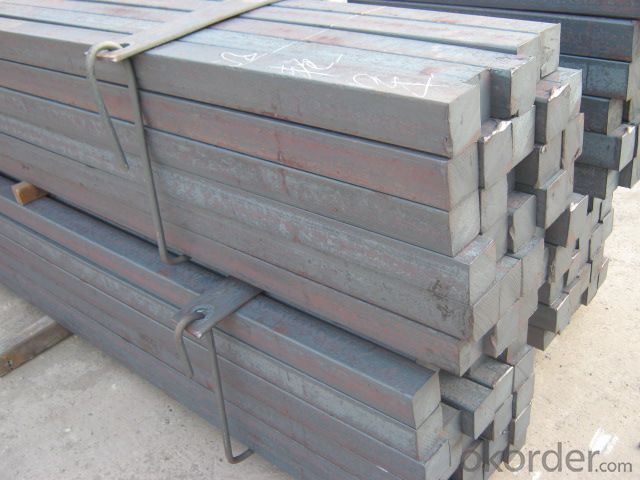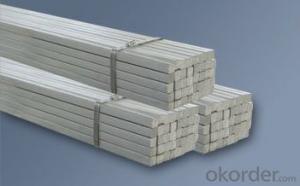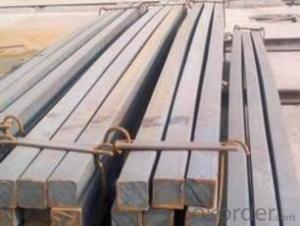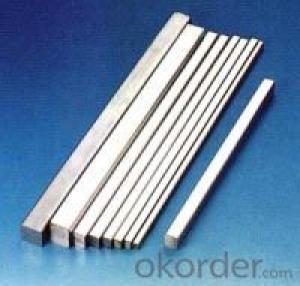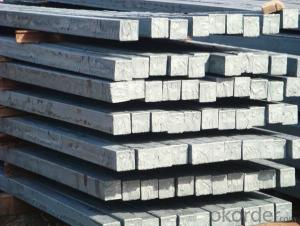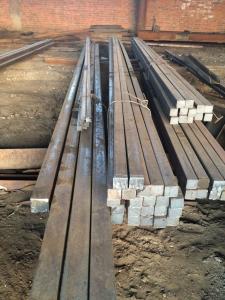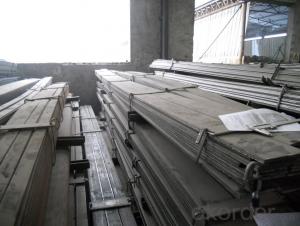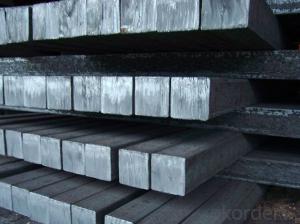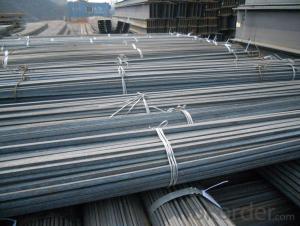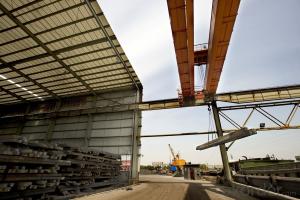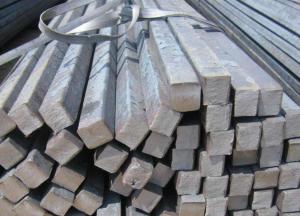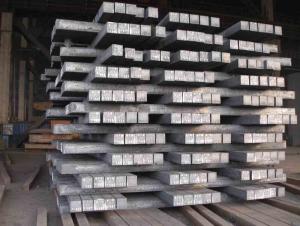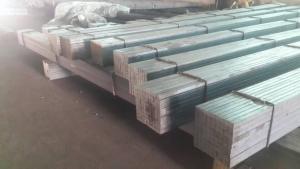Q275B Square bar hot quality for construction
- Loading Port:
- Tianjin
- Payment Terms:
- TT or LC
- Min Order Qty:
- 10000 m.t.
- Supply Capability:
- 10000 m.t./month
OKorder Service Pledge
OKorder Financial Service
You Might Also Like
Product Description:
OKorder is offering Q275B Square bar hot quality for construction at great prices with worldwide shipping. Our supplier is a world-class manufacturer of steel, with our products utilized the world over. OKorder annually supplies products to European, North American and Asian markets. We provide quotations within 24 hours of receiving an inquiry and guarantee competitive prices.
Product Applications:
Q275B Square bar hot quality for construction are ideal for structural applications and are widely used in the construction of buildings and bridges, and the manufacturing, petrochemical, and transportation industries.
Product Advantages:
OKorder's Q275B Square bar hot quality for construction are durable, strong, and resist corrosion.
Main Product Features:
-Standard: GB,
-Grade: Q195 or equivalent.
-Chemical Composition:
Standard | Grade | Element (%) | ||||
GB | Q195 | C | Mn | S | P | Si |
0.06~0.12 | 0.25~0.50 | ≤0.050 | ≤0.045 | ≤0.30 | ||
Measures of HR Square Bar (small measures):

(Section of HR Square Bar)
-Length of a side and Theoretical weight of Square Bar.
Length of a side(mm) | Theoretical weight(kg/m) | Length of a side(mm) | Theoretical weight(kg/m) |
7 | 0.385 | 22 | 3.80 |
8 | 0.502 | 24 | 4.52 |
9 | 0.636 | 25 | 4.91 |
10 | 0.785 | 26 | 5.30 |
11 | 0.950 | 28 | 6.15 |
12 | 1.13 | 30 | 7.06 |
13 | 1.33 | 32 | 8.04 |
14 | 1.54 | 34 | 9.07 |
15 | 1.77 | 36 | 10.17 |
16 | 2.01 | 38 | 11.24 |
17 | 2.27 | 40 | 12.56 |
18 | 2.54 | 42 | 13.85 |
19 | 2.82 | 45 | 15.90 |
20 | 3.14 | 48 | 18.09 |
21 | 3.46 | 50 | 19.63 |
Notes:
1, The theoretical weights in the list, base on the density of 7.85 g/cm3.
2, Formula for theoretical weight of Square bar: (length of a side)2 * 0.00785
3, The numbers with *mean that they are not regular or we don’t offer them.
-Regular length of Square Bar:
Steel | Length of a side (mm) | Length of steel (m) |
Normal steel | < 25 | 4~10 |
> 25 | 3~9 | |
Steel of high quality | All measure | 2~6 |
Tool steel >75 | 1~6 |
Usage/Applications of HR Square Bar:
-The Square Bar is normally used as structure steel.
-Row material for other structure steel like steel angles, channels, I-beams, H-beams, etc…
Packaging & Delivery of HR Square Bar:
-Packing Detail: The products can be packed in bundles by steel wires.
-Marks: We make tag marks and color marks. The tag marks with white background and red company logo will be tied up to each bundle of the products. The information is usually including basic information of products and company and other information requested by customers. As for color marks, we will paint both ends of bundles to make sure that it will be more convenient for customers to distinguish them from other products.
-Delivery Detail: 30~45 working days after receive buyer’s T.T. or L/C.
Transportation:
-The products can be delivered by bulk vessel or by container. As for container, products with the length of 6m will be loaded in 20’ container, with 9m or 12m, in 40’ container.
-The maximum quantity of loading of container is 25 tons.
-The products are usually transported to the nearest port from the production place.
FAQ:
Q1: How soon can we receive the product after purchase?
A1: Within three days of placing an order, we will begin production. The specific shipping date is dependent upon international and government factors, but is typically 7 to 10 workdays.
Q2: Can stainless steel rust?
A2: Stainless does not "rust" as you think of regular steel rusting with a red oxide on the surface that flakes off. If you see red rust it is probably due to some iron particles that have contaminated the surface of the stainless steel and it is these iron particles that are rusting. Look at the source of the rusting and see if you can remove it from the surface.
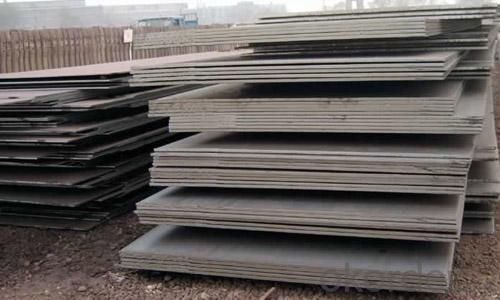
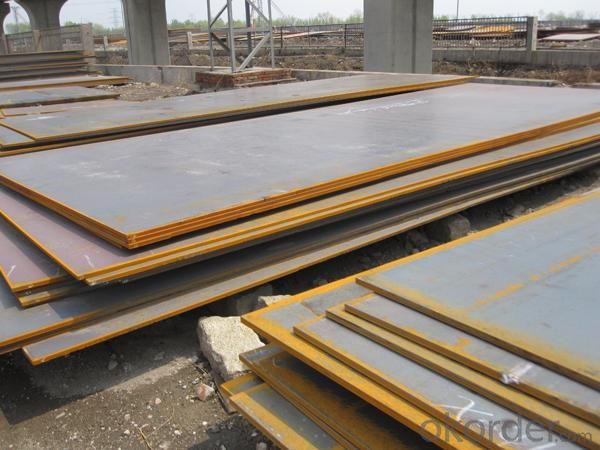
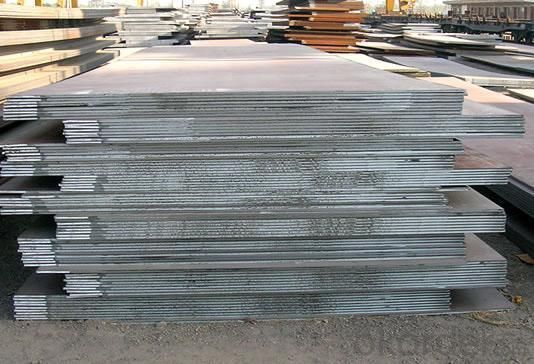
- Q: How do you use a steel square for creating parallel lines?
- To create parallel lines using a steel square, follow these steps: 1. Place the steel square onto the surface or material where the parallel lines are desired. 2. Align one edge of the steel square with the reference point or starting edge for the parallel lines. 3. Securely hold the steel square in place to prevent any movement. 4. Use a pencil or marking tool to make a mark or draw a line along the edge of the steel square. 5. Without shifting the steel square, glide it along the surface or material while maintaining alignment with the reference point. 6. Make another mark or draw another line along the edge of the steel square at the desired distance from the previous line. 7. Repeat this process for the desired number of parallel lines, consistently aligning the same edge of the steel square with the reference point and marking along the opposite edge. By consistently aligning the steel square with the reference point and marking along its edges, one can create multiple parallel lines with precision and accuracy.
- Q: How do you use a steel square to create cove cuts?
- To use a steel square to create cove cuts, you can follow these steps: 1. Begin by marking the desired cove shape on the workpiece, using a pencil or marking tool. 2. Position the steel square on the marked line, aligning one edge of the square with the curve. 3. Hold the square firmly in place and use a pencil or scribe to trace along the inside edge of the square, transferring the curve onto the workpiece. 4. Repeat this process at different points along the curve to ensure accuracy and smoothness. 5. Once the curve is traced, you can use a jigsaw, coping saw, or any other suitable cutting tool to carefully cut along the marked line, following the curve. 6. After the cut is complete, you may need to smooth and refine the cove using sandpaper, a file, or other finishing tools, depending on the desired result. Remember to take your time, use caution, and always wear appropriate safety gear when working with tools and machinery.
- Q: Can a steel square be used for measuring pipe diameters?
- No, a steel square cannot be used for measuring pipe diameters accurately. A steel square is primarily used for measuring right angles and checking the straightness of edges. It consists of a long steel ruler with a perpendicular arm called a tongue. While it can be helpful in some construction and woodworking tasks, it is not designed for measuring pipe diameters. To accurately measure the diameter of a pipe, one would typically use a caliper, tape measure, or a specialized tool such as a pipe diameter tape. These tools are specifically designed to measure the circumference or diameter of cylindrical objects like pipes.
- Q: How do you use a steel square for marking and cutting tenons with shoulders?
- For marking and cutting tenons with shoulders, the following steps should be followed when using a steel square: 1. Before starting, make sure that the steel square is clean and free from rust or debris. This will guarantee accurate measurements and markings. 2. To begin, measure the width of the tenon on the piece of wood being worked on. Place the steel square on the wood's edge, aligning the inside edge of the square with the desired width measurement. 3. Once the square is aligned, use a pencil or marking knife to mark the tenon's width on the wood. It is important to mark both sides of the wood for accuracy. 4. Next, determine the tenon's depth. Measure the desired depth on the wood's end, perpendicular to the width marking. This will be the length of the shoulder on each side of the tenon. 5. Position the steel square on the wood's end, aligning the inside edge of the square with the depth measurement. Use a pencil or marking knife to mark the shoulder depth on each side of the wood. 6. After marking the tenon's width and shoulder depth, proceed to cut it. Use a saw to carefully cut along the width marking, stopping at the shoulder depth marking. Repeat this on the other side of the wood to create the tenon. 7. Once the tenon is cut, refine the shoulders using a chisel or shoulder plane. Carefully remove any excess wood to create a clean and flat surface for the shoulders. 8. Finally, check the fit of the tenon by inserting it into the corresponding mortise or joint. Make any necessary adjustments to the width or shoulder depth until the tenon fits snugly. By utilizing a steel square, precise measurements and markings can be ensured when marking and cutting tenons with shoulders. This will result in a sturdy and accurate joint that fits together seamlessly.
- Q: How can a steel square be used for making accurate cuts?
- Accurate cuts in woodworking or metalworking projects can be achieved with the use of a steel square. This precision measuring tool possesses a 90-degree angle and a straight edge, making it perfect for creating precise right angles. To make accurate cuts using a steel square, begin by marking the desired cut line on your material using a pencil or scribe. Next, position the steel square on the material, ensuring that one side of the square aligns with the marked cut line. Press the square's straight edge firmly against the material to guarantee a precise cut. Proceed by using a sharp tool, such as a saw or cutting torch for metal, to follow the edge of the steel square and cut along the marked line. The steel square acts as a reliable guide, guaranteeing a straight and accurate cut. Moreover, a steel square can also be used to verify the accuracy of existing cuts. Simply place the square against the cut edge to determine if it is perpendicular. If adjustments are required, they can be made accordingly. To summarize, a steel square is a versatile tool that facilitates accurate cuts by providing a straight edge and a 90-degree angle. This ensures precise measurements and guides the cutting tool effectively.
- Q: How do you use a steel square for marking and cutting dovetail joints?
- In order to mark and cut dovetail joints using a steel square, there are a few steps that must be followed. Firstly, it is important to make sure that the steel square is clean and devoid of any dirt or rust. This will ensure that the markings are precise and accurate. Next, position the steel square firmly against the wood's edge that you wish to mark. Ensure that it is flush against the wood and securely held in place. Subsequently, using a sharp marking knife or pencil, trace along the edge of the steel square. This will generate a straight and precise line on the wood. When marking dovetail joints, it is usually necessary to mark both the pins and the tails. To accomplish this, place the steel square on the end grain of the wood, aligning it with the edge where the dovetails will be cut. Once again, trace along the steel square to create the lines for the pins and tails. To cut the dovetail joints, a dovetail saw or coping saw can be utilized. Align the saw blade with the marked lines and cautiously cut along them, following the angles of the dovetail joint. Always exercise caution and take your time to guarantee accuracy. It may be beneficial to practice on scrap wood before attempting to cut the actual dovetail joint.
- Q: Can a steel square be used for measuring the pitch of a roof?
- Yes, a steel square can be used for measuring the pitch of a roof. A steel square, also known as a framing square or carpenter's square, is a versatile tool used by carpenters and roofers for various measurements and calculations. To measure the pitch of a roof, you can use the square's graduated scales and angles to determine the angle and slope of the roof. By placing the square on the roof's surface and aligning it with the rafters or trusses, you can easily determine the pitch by reading the scale or using the square's built-in formulas. However, it is important to note that using a steel square may not provide the most accurate measurements for complex or irregular roof shapes, and specialized roofing tools or instruments may be more suitable in those cases.
- Q: How do you use a steel square for marking and cutting angled mortise and tenon joints?
- In order to mark and cut angled mortise and tenon joints using a steel square, it is necessary to follow a series of steps: 1. Begin by determining the desired angle for the joint. This can be accomplished by utilizing a protractor or referencing a specific angle measurement. 2. Once the angle has been established, position the steel square along the edge of the wood to be cut. Ensure that the long side of the square aligns with the wood's edge. 3. Employ a pencil or marking knife to indicate the desired length of the tenon on the wood's face. This will serve as the portion that fits into the mortise. 4. Next, employ the short side of the steel square to mark the shoulder line of the tenon on both the face and edge of the wood. The shoulder line denotes the point of contact between the tenon and the mortise, creating a clean and flush joint. 5. Subsequently, using the same angle, transfer the marks onto the wood piece that will contain the mortise. Ensure that the marks align with those made on the tenon piece. 6. Utilize a chisel or mortising machine to remove the excess material within the marked shoulder lines on the wood piece with the mortise. Take care and proceed meticulously to achieve precise and clean material removal. 7. Finally, employ a saw or chisel to cut along the marked tenon lines on the tenon piece, eliminating the surplus material and shaping the tenon to fit snugly into the mortise. Always remember to measure twice and cut once to guarantee accuracy.
- Q: How does a steel square assist in checking the alignment of power tools?
- A steel square assists in checking the alignment of power tools by providing a straight and accurate reference edge or surface. It can be used to ensure that the tool's blade or fence is perfectly perpendicular or parallel to the reference edge, allowing for precise and accurate cuts or measurements.
- Q: Are square steel, rectangular tube and angle steel shaped or light steel?
- Square steel, rectangular tube and angle steel belong to section steel, light steel and section steel are not tied together.1., light steel is also a relatively vague term, generally can have two kinds of understanding. One is the current "code for design of steel structures" (GBJ 17-88) in the eleventh chapter "bar, small angle light steel structure", refers to the use of steel and light steel structure is less than L45*4 and L56*36*4 angle steel production, mainly in the lack of time for small steel structure manufacturing of reinforced concrete structure should not be used, has been basically not used, so the revised code for design of steel structures has been basically removed this tendency. The other is the "Regulations" technology of steel structure of light-weight buildings with gabled frames with light roof and wall light (also has the condition to use the masonry wall) single portal frame structure, the light here mainly refers to the enclosure is made of light material. Since the former has been cancelled soon, the meaning of "light steel" mainly refers to the latter
Send your message to us
Q275B Square bar hot quality for construction
- Loading Port:
- Tianjin
- Payment Terms:
- TT or LC
- Min Order Qty:
- 10000 m.t.
- Supply Capability:
- 10000 m.t./month
OKorder Service Pledge
OKorder Financial Service
Similar products
Hot products
Hot Searches
Related keywords
